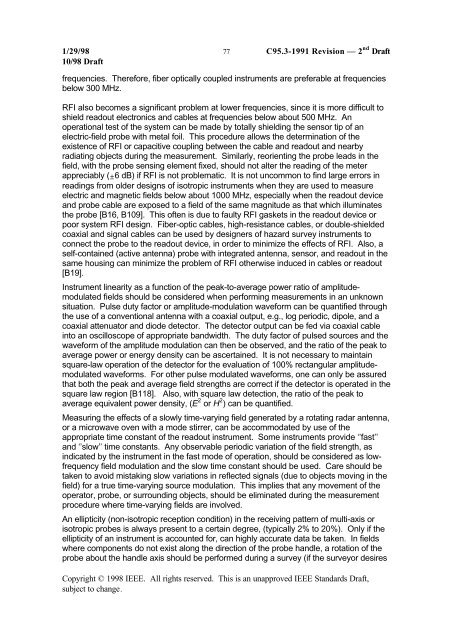DRAFT Recommended Practice for Measurements and ...
DRAFT Recommended Practice for Measurements and ...
DRAFT Recommended Practice for Measurements and ...
Create successful ePaper yourself
Turn your PDF publications into a flip-book with our unique Google optimized e-Paper software.
1/29/98 77 C95.3-1991 Revision — 2 nd Draft<br />
10/98 Draft<br />
frequencies. There<strong>for</strong>e, fiber optically coupled instruments are preferable at frequencies<br />
below 300 MHz.<br />
RFI also becomes a significant problem at lower frequencies, since it is more difficult to<br />
shield readout electronics <strong>and</strong> cables at frequencies below about 500 MHz. An<br />
operational test of the system can be made by totally shielding the sensor tip of an<br />
electric-field probe with metal foil. This procedure allows the determination of the<br />
existence of RFI or capacitive coupling between the cable <strong>and</strong> readout <strong>and</strong> nearby<br />
radiating objects during the measurement. Similarly, reorienting the probe leads in the<br />
field, with the probe sensing element fixed, should not alter the reading of the meter<br />
appreciably (±6 dB) if RFI is not problematic. It is not uncommon to find large errors in<br />
readings from older designs of isotropic instruments when they are used to measure<br />
electric <strong>and</strong> magnetic fields below about 1000 MHz, especially when the readout device<br />
<strong>and</strong> probe cable are exposed to a field of the same magnitude as that which illuminates<br />
the probe [B16, B109]. This often is due to faulty RFI gaskets in the readout device or<br />
poor system RFI design. Fiber-optic cables, high-resistance cables, or double-shielded<br />
coaxial <strong>and</strong> signal cables can be used by designers of hazard survey instruments to<br />
connect the probe to the readout device, in order to minimize the effects of RFI. Also, a<br />
self-contained (active antenna) probe with integrated antenna, sensor, <strong>and</strong> readout in the<br />
same housing can minimize the problem of RFI otherwise induced in cables or readout<br />
[B19].<br />
Instrument linearity as a function of the peak-to-average power ratio of amplitudemodulated<br />
fields should be considered when per<strong>for</strong>ming measurements in an unknown<br />
situation. Pulse duty factor or amplitude-modulation wave<strong>for</strong>m can be quantified through<br />
the use of a conventional antenna with a coaxial output, e.g., log periodic, dipole, <strong>and</strong> a<br />
coaxial attenuator <strong>and</strong> diode detector. The detector output can be fed via coaxial cable<br />
into an oscilloscope of appropriate b<strong>and</strong>width. The duty factor of pulsed sources <strong>and</strong> the<br />
wave<strong>for</strong>m of the amplitude modulation can then be observed, <strong>and</strong> the ratio of the peak to<br />
average power or energy density can be ascertained. It is not necessary to maintain<br />
square-law operation of the detector <strong>for</strong> the evaluation of 100% rectangular amplitudemodulated<br />
wave<strong>for</strong>ms. For other pulse modulated wave<strong>for</strong>ms, one can only be assured<br />
that both the peak <strong>and</strong> average field strengths are correct if the detector is operated in the<br />
square law region [B118]. Also, with square law detection, the ratio of the peak to<br />
average equivalent power density, (E 2 or H 2 ) can be quantified.<br />
Measuring the effects of a slowly time-varying field generated by a rotating radar antenna,<br />
or a microwave oven with a mode stirrer, can be accommodated by use of the<br />
appropriate time constant of the readout instrument. Some instruments provide ‘’fast’’<br />
<strong>and</strong> ‘’slow’’ time constants. Any observable periodic variation of the field strength, as<br />
indicated by the instrument in the fast mode of operation, should be considered as lowfrequency<br />
field modulation <strong>and</strong> the slow time constant should be used. Care should be<br />
taken to avoid mistaking slow variations in reflected signals (due to objects moving in the<br />
field) <strong>for</strong> a true time-varying source modulation. This implies that any movement of the<br />
operator, probe, or surrounding objects, should be eliminated during the measurement<br />
procedure where time-varying fields are involved.<br />
An ellipticity (non-isotropic reception condition) in the receiving pattern of multi-axis or<br />
isotropic probes is always present to a certain degree, (typically 2% to 20%). Only if the<br />
ellipticity of an instrument is accounted <strong>for</strong>, can highly accurate data be taken. In fields<br />
where components do not exist along the direction of the probe h<strong>and</strong>le, a rotation of the<br />
probe about the h<strong>and</strong>le axis should be per<strong>for</strong>med during a survey (if the surveyor desires<br />
Copyright © 1998 IEEE. All rights reserved. This is an unapproved IEEE St<strong>and</strong>ards Draft,<br />
subject to change.
















